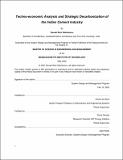Techno-economic Analysis and Strategic Decarbonization of the Indian Cement Industry
Author(s)
Sakhamuru, Devaki Rani
DownloadThesis PDF (20.64Mb)
Advisor
de Weck, Olivier
Gençer, Emre
Terms of use
Metadata
Show full item recordAbstract
India, being a developing nation, will witness tremendous growth in the industrial sector, particularly cement production and consumption for constructing its buildings, roads, and other infrastructure. As India's GDP strengthens due to its industrial growth, living standards will rise too, increasing consumption patterns and CO₂ emissions. Climate change is border agnostic. Its effects are everywhere and transcend across nations. The success of the world's ability to limit the global rise in temperatures to under 2°C or 1.5°C to meet climate goals depends heavily on India's ability to decarbonize its fast-growing industry sector, primarily cement and iron & steel.
For India to decarbonize its cement sector, several challenges exist calling for strategic decision making in the Indian Cement Industry to mitigate climate impacts and carbon taxes in the future. First, most CO₂ emissions arise not from energy consumption but process emissions resulting from the chemical reaction of decomposition of limestone into lime during clinker making. It makes cement a hard-to-abate sector as long as the process involves calcination of limestone unless extreme measures are undertaken, such as Carbon Capture and Storage (CCS) or CCUS technologies. Second, these emerging technologies are still not feasible due to high implementation costs, financial barriers, and technology readiness level (TRL). Unlike in China, where the majority of plants are state owned and have access to capital, the cement industry in India has to raise capital on its own or be subject to being bought out by international firms that have access to larger, low-cost capital. Moreover, India has an abundance of low-grade limestone but limited high-grade limestone which is used in OPC clinker suitable for construction. India has already started importing limestone for OPC clinker making due to limited reserves of high-grade limestone that present a dependence on imports and pose raw material risks. This research investigates possible ways to decarbonize on the supply side, demand side, and operational side, and explores the pathways to reach the target emission intensity of 0.35 tonne of CO₂ per tonne of cement to meet the climate goals while considering these constraints.
The findings suggest that improving grid emission intensity or using alternative fuels alone will not be sufficient to achieve the target intensity as the majority of emissions result from process emissions during chemical reaction of calcination of limestone. Additionally, the IEA prescribed roadmap to achieve the target emission intensity of 0.35 t of CO₂ per t of cement is not possible without a major capital expenditure (CAPEX) and new technologies like CCS. Continuing to utilize high-emission intensive and high-grade limestone-based clinker coupled with setting up costly CCS infrastructure for limestone-based cement alone may not be a feasible strategy due to dwindling resources that may cause these systems to become obsolete in the future.
Considering these factors, alternative binders with varying emission intensities and raw material reserves such as geopolymers and other green cement types were optimized to solve for the ideal mix that achieves the emission intensity target of 0.35 t CO₂/ t cement. The closest optimization result to the target was 0.37 t CO₂/ t cement when using the following industry production mix: OPC 21%, PPC 20%, PSC 10%, and Geopolymers 39%. For this scenario to be practical, there has to be more research on the geopolymers which require additional research and development to bring from lab to market. This means there is no one solution, but considering to bring such cements into market is perhaps a better and cost-effective alternative when coupled with grid intensity and alternative fuels and raw materials in a circular economy. While decarbonizing CO2 emissions by improving grid intensity and alternative fuels alone are insufficient for long-term decarbonization goals, they, when coupled with the green cement mix have the potential to limit temperature rise to 2°C.
While CCUS can abate the industrial sector to meet climate goals and relevant when the carbon tax is imposed, limitations exist in technology, financial barriers, and raw material risks (such as limited availability of high-grade limestone reserves). An excessive carbon tax would might kill the growing industry. Therefore, the industry needs to explore new cement types such as geopolymers, and further extend system boundary to decarbonize the energy system and to include the transportation system for benefiting from the logistics optimization.
Finally, the research recommends policy makers to consider diverting R&D funds towards non-limestone-bearing raw materials and binders, especially for developing geopolymer and novel cement that requires chemical bonding instead of lime to reduce CO₂ emissions from cement sector. Existing research has already demonstrated that a circular economy has high potential to lower emissions at the lowest cost. Facilitating an efficient circular economy system will require expansion of system boundary, and will need diverting funds into R&D for developing integrated systems and capabilities but is the most effective route for the Indian cement industry that has limited access to capital and limestone-bearing raw material risks.
Date issued
2022-05Department
System Design and Management Program.Publisher
Massachusetts Institute of Technology